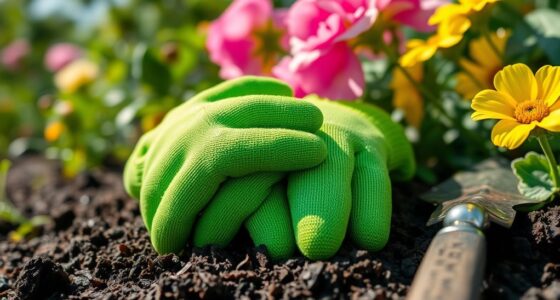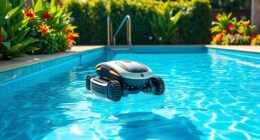Starting a vegetable garden from seed is all about timing and preparation. First, know your local climate and plant when frost danger has passed. Read seed packets for planting depth and spacing. Sterilize old pots to prevent disease and use grow lights for healthy growth. Protect your seeds from pests with plant collars and row covers. Remember to water correctly and thin out seedlings as they grow for better airflow. You’ll find even more tips to guarantee a thriving garden.
Key Takeaways
- Determine your local climate and frost dates to time your planting for optimal growth and yield.
- Start slow-growing seeds indoors 6-8 weeks before the last frost for a head start.
- Follow seed packet instructions for planting depth, spacing, and thinning to ensure healthy seedling development.
- Use sterilized containers and fresh seed-starting mix to prevent diseases and promote robust growth.
- Monitor soil conditions and provide adequate light, nutrients, and pest protection for thriving plants.
Know When to Plant
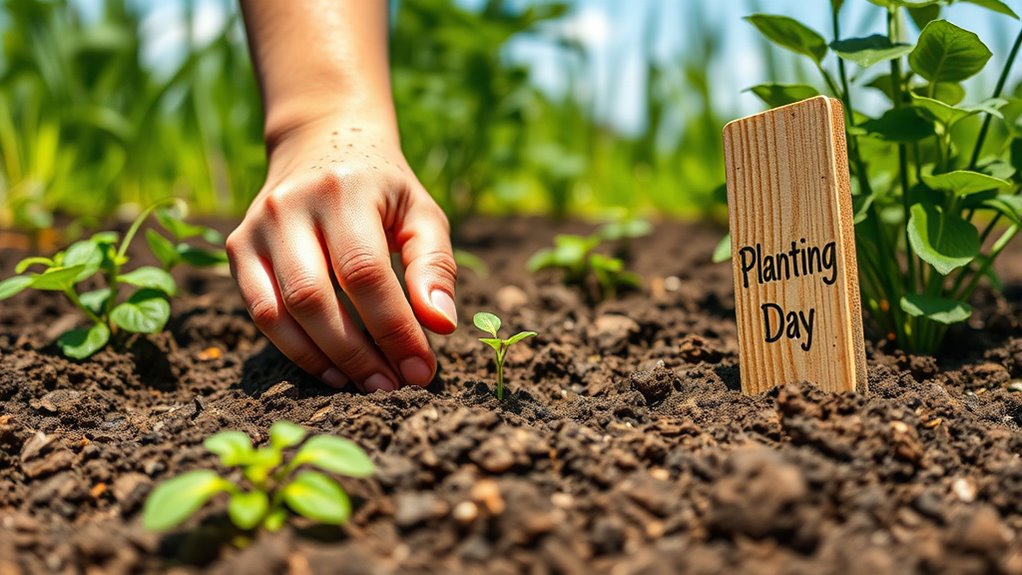
To successfully grow vegetables, you need to know when to plant them. Make sure to understand your local climate and frost dates, as these determine the ideal growing season for your vegetable seeds.
Slow-growing vegetables like tomatoes and peppers should be started indoors 6-8 weeks before the last expected frost. In contrast, fast-growing crops like beans and radishes can be sown directly in the garden once frost danger has passed. Additionally, using self-watering planters can help maintain consistent moisture levels for your vegetable seeds, which is crucial for promoting healthy growth and preventing root rot. Regularly monitoring air quality can also help ensure a healthy environment for your plants as they grow.
A good rule of thumb is to monitor soil temperature; many seeds sprout best at around 60°F. Also, be aware that some seeds, such as lettuce, require light for germination, so know which to sow on the surface versus those that can be buried. Additionally, understanding long-term financial planning for your gardening expenses can help you manage costs effectively as you grow your vegetable garden.
Read the Seed Packets

Seed packets are your best friends when it comes to starting a vegetable garden. They provide vital information that’ll help you make the most of your seeds indoors and guarantee successful germination.
Seed packets are essential for vegetable gardening, offering crucial details for successful seed germination and growth.
Pay close attention to the details on each packet, including:
- Days to harvest
- Recommended planting times
- Specific planting depths
- Spacing guidelines for young seedlings
Some seeds thrive when started indoors, while others prefer direct sowing outdoors. Following these instructions not only maximizes your yield but also promotes healthy growth. Additionally, consider the nutritional benefits of incorporating beetroot into your diet, as this vegetable is rich in vitamins and minerals that can support overall health. For example, broccoli farming tips emphasize the importance of consistent moisture for optimal seedling growth. Furthermore, ensuring color accuracy in your plant choices can enhance your garden’s visual appeal and overall health. You might also enjoy planting Turkey Bean and Tomato Zoodle Bowl ingredients to create delicious meals from your garden harvest.
Using plant collars can help protect your young seedlings as they establish themselves. By reading and adhering to the seed packet guidelines, you’ll set yourself up for a flourishing vegetable garden.
Sterilize Old Pots and Trays
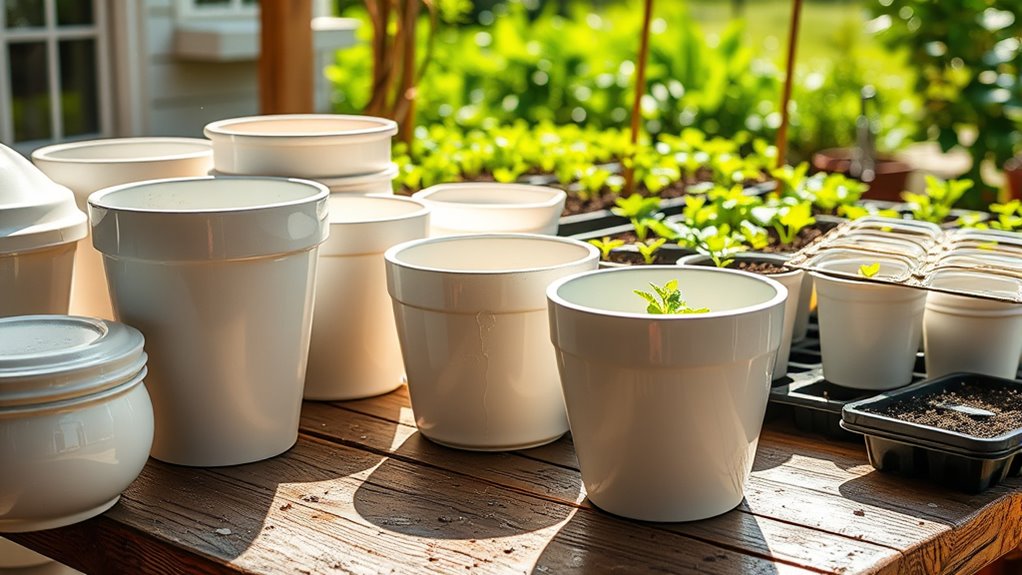
Before you start planting, it’s essential to sterilize old pots and trays to protect your seedlings from diseases like damping off. You can achieve this by soaking your containers in a solution of 10% bleach or hydrogen peroxide for 10-15 minutes. Make certain to clean all surfaces, including drainage holes, to eliminate any lingering pathogens.
| Solution | Soak Time | Purpose |
|---|---|---|
| 10% Bleach | 10-15 min | Kills bacteria and fungi |
| Hydrogen Peroxide | 10-15 min | Disinfects and cleans |
| New Seed-Starting Mix | N/A | Guarantees healthy growth |
Use Grow Lights
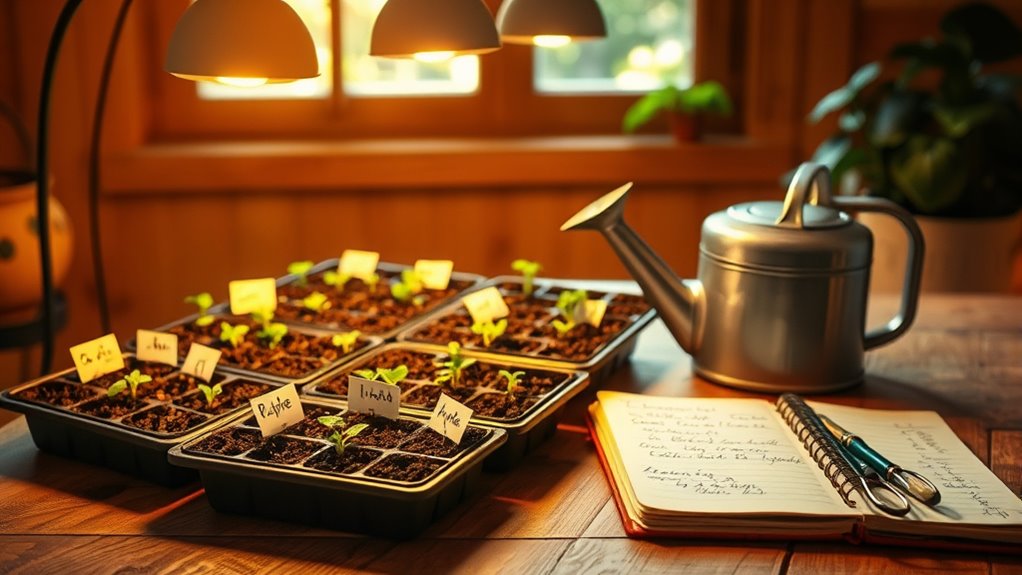
Using grow lights can greatly enhance the success of your vegetable garden, especially when natural sunlight is limited.
Whether you’re starting indoors or in a specific growing zone, providing the right light is essential for your tender seedlings. Backyard greenhouses can also be an excellent solution to optimize light exposure and create a more organized environment that fosters mental clarity.
Here’s how to effectively use grow lights:
- Choose eco-friendly LED grow lights for energy efficiency and ideal spectrum.
- Position the lights about 3 inches above your seedlings to prevent heat stress.
- Use timers to guarantee your seedlings need at least 12 hours of light daily.
- Regularly adjust the height of the lights as your seedlings grow taller.
Additionally, integrating sustainable practices such as curated lists can further support your gardening efforts.
With these tips, your seedlings will thrive, assuring a bountiful vegetable garden when it’s time to transplant!
Protect Seeds From Pests
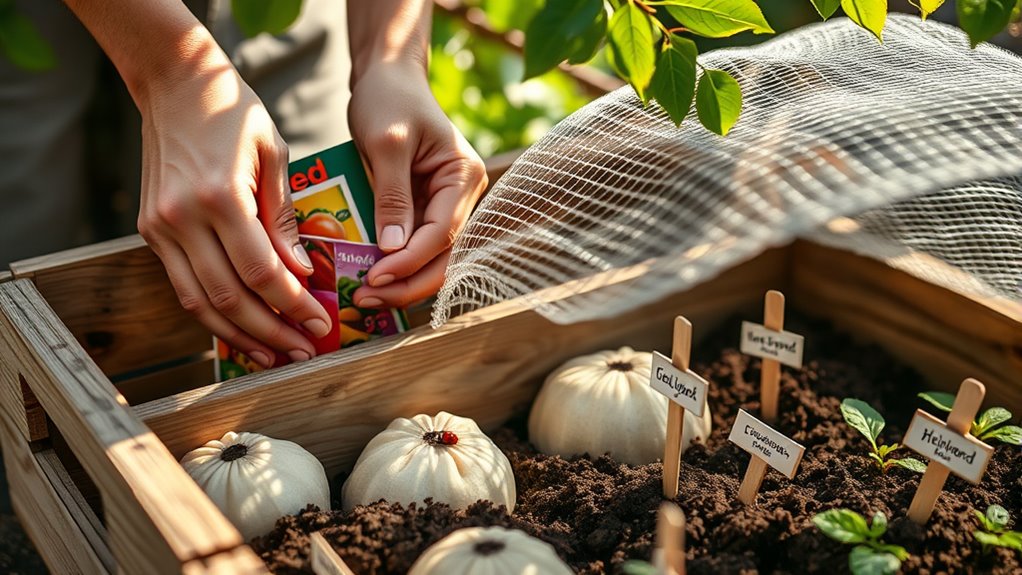
After guaranteeing your seedlings receive the right amount of light, it’s time to focus on protecting them from pests.
Start by covering outdoor seeds with moistened paper towels to deter birds from pecking at them as they germinate. It’s vital to monitor for pests during this phase; early detection can greatly improve seed survival rates and is a key aspect of measuring success in gardening. For those interested in foraging, understanding local ecosystems can provide insights into wild edibles that may benefit your gardening efforts. Additionally, using organic pest deterrents can be an effective strategy to safeguard your seedlings from unwanted visitors.
Use plant collars made of plastic, cardboard, or aluminum foil around seedlings to defend against cutworms and other soil-dwelling pests.
Consider utilizing row covers as a physical barrier against insects while still allowing sunlight and moisture to reach your seeds.
Regularly inspect your seedlings for signs of pest damage and opt for organic pest deterrents to guarantee healthy growth. Incorporating spiritual principles into your gardening practice can enhance your connection with nature and promote a sense of peace.
Water Correctly
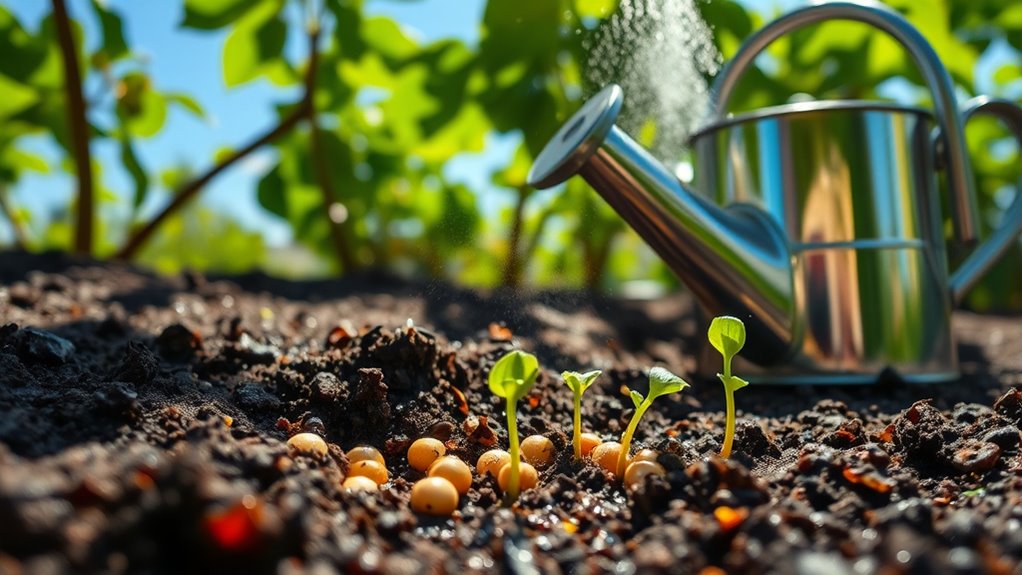
Watering your seedlings correctly is essential for their healthy growth. To guarantee they thrive, keep these tips in mind:
- Use a pre-moistened seed-starting mix to maintain consistent moisture without over-saturating the soil.
- Water gently using misting or bottom watering techniques to avoid disturbing the soil.
- For outdoor seeds, use a watering can or hose to keep the soil evenly moist during germination.
- Consider humidity domes to help retain moisture during germination, but remove them once seedlings sprout to prevent excess humidity. Incorporating high-fiber foods in your diet can support digestive health, which is beneficial for overall well-being. Additionally, maintaining a structured routine can help ensure consistent care for your garden. Chia seeds, for example, thrive in well-drained soil and require consistent moisture for optimal growth.
Regularly monitor soil moisture levels, as both over-watering and under-watering can hinder your seedlings’ growth. Additionally, incorporating solar energy solutions can provide an eco-friendly way to power any irrigation systems you may wish to use.
Thin Out Seedlings as They Grow

As your seedlings grow, thinning them out becomes crucial for their overall health and development. When your seedlings have one to two sets of true leaves, it’s time to thin them.
This process prevents overcrowding, allowing stronger plants to access sufficient light, nutrients, and water for healthy growth. Aim for proper spacing of 2 to 4 inches apart, depending on the vegetable variety. Additionally, seasonal influences can affect the growth rate of your seedlings, so be sure to consider the time of year when planning your garden. In larger gardens, ideal flock size of chickens can also be managed alongside your vegetable crops for enhanced productivity.
Regularly monitoring seedling growth guarantees you can identify when to thin. When removing weaker seedlings, use scissors to cut them at the base, avoiding disturbance to the roots of the remaining plants.
This careful attention will promote ideal development and reduce competition for resources, giving your garden the best chance for success. Additionally, ensuring adequate space between seedlings helps them thrive and minimizes strain on available nutrients.
Frequently Asked Questions
What Month Should I Start My Vegetable Seeds?
You should start your vegetable seeds indoors between late February and early April, depending on your local climate.
If you’re growing fast crops like radishes or beans, you can sow them directly outdoors as early as March.
For slower-growing plants like tomatoes, start them indoors 6-8 weeks before the last frost.
Always check your seed packets for specific planting dates tailored to your region, ensuring a successful growing season.
Can I Just Throw Seeds on the Ground?
Throwing seeds on the ground is like tossing coins into a wishing well; you might get lucky, but it’s risky. Most seeds need specific depths and conditions to germinate properly.
If you don’t follow the guidelines on the seed packets, you could end up with sparse plants. Instead, prepare your soil and plant seeds at the right depth and spacing.
It’ll give your garden the best chance to thrive and flourish.
What Is the Best Month to Start a Vegetable Garden?
The best month to start a vegetable garden really depends on where you live.
In many temperate regions, you’ll find that late March to early April is ideal for sowing seeds indoors, especially if you’re growing warm-season crops.
For some areas, you might even start as early as February for cool-weather veggies.
Always check local planting calendars and frost dates to guarantee you’re planting at the right time for your climate.
What Vegetable Seeds Need to Be Started Inside?
If you’re looking to start vegetable seeds indoors, focus on slow-growing varieties like tomatoes and peppers.
These seeds need to be started about 6 to 8 weeks before the last expected frost date.
Make sure you keep them warm, ideally between 70-80°F (21-27°C), and use a seed-starting mix for proper drainage.
Providing at least 12 hours of light daily will help your seedlings grow strong and healthy without becoming leggy.
Conclusion
Starting a vegetable garden from seed is like nurturing a tiny dream into reality. By following these steps, you’ll cultivate healthy plants that can thrive in your garden. Remember to keep an eye on your seedlings, ensuring they get the right light, water, and protection. With a little patience and care, you’ll soon enjoy the fruits of your labor, transforming your patch of earth into a vibrant oasis of fresh vegetables. Happy gardening!




